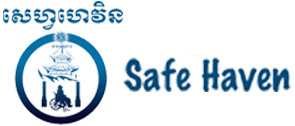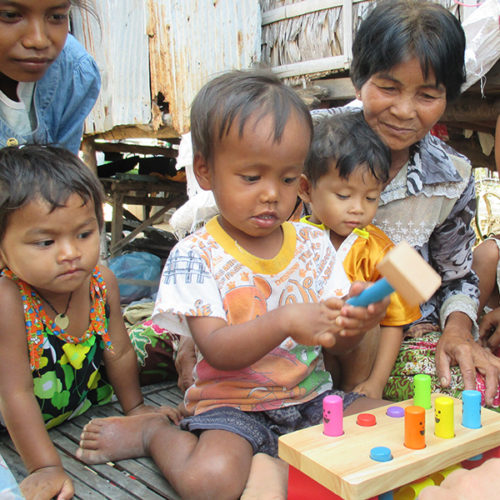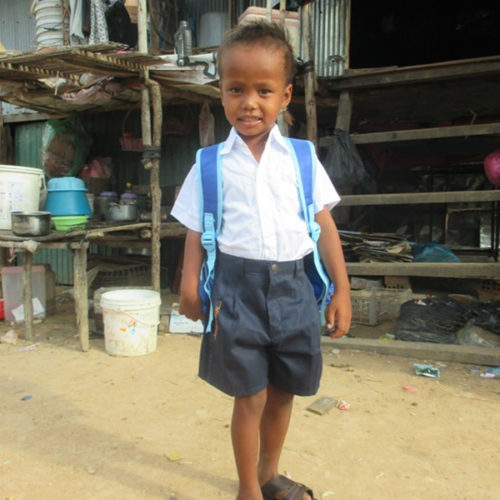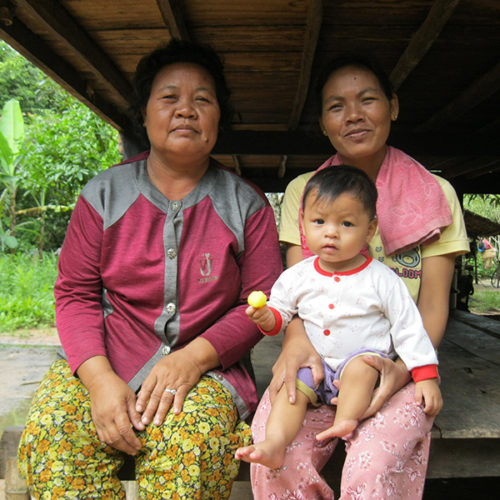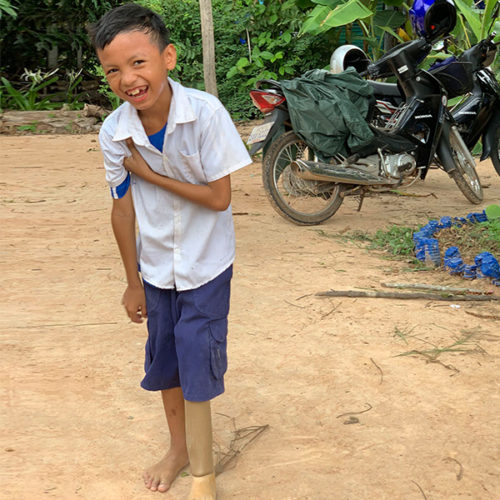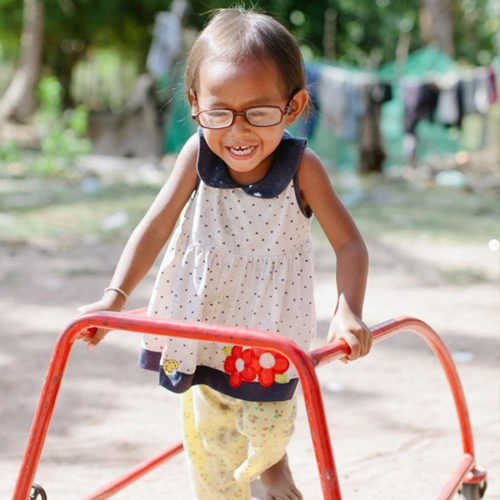Before
After
V was referred to Safe Haven by another Safe Haven family who lived nearby. At that time, he was 4 years old and had weakness and loss of function in his right arm and leg. He was living with his grandmother, who was struggling to raise several of her grandchildren and scavenged for recycling to support them.
When we first met V, he was afraid of the SH staff and cried at the first assessment visit. Over time, he came to understand that SH staff usually brought fun activities and games and began looking forward to visits. Safe Haven’s Physiotherapist and Interventionist worked on activities to strengthen his weaker arm and leg, while the Nurse addressed medical and dental needs and the Social Worker worked on assessing the challenges and strengths of the family.
Slowly, with Safe Haven’s treatment and support, V’s strength and function improved. He was able to walk and run, almost able to keep up with other children despite some residual weakness in his right leg. He was able to use his hands well enough to manage some daily activities like bathing and dressing independently.
Safe Haven was able to enlist the help of a partner NGO, This Life Cambodia, and collaborated with them to overcome the challenges for V’s school attendance. V started school and has been attending regularly! His physical disabilities do not prevent him from joining in with other children on the playground or the classroom, he can use the bathroom independently at school, and he is learning alongside his peers.
After more than three years of treatment and support from Safe Haven, V is ready to learn and happy to attend school – our long-term goals for him have been achieved!
Before
After
In 2011, Safe Haven welcomed one of our 1st Early Intervention kids: a 15-month-old boy living with his parents, sibling and grandmother in a village in Siem Reap. Like many of our Safe Haven families, his family struggled with poverty and a lack of basic resources. Although he was generally healthy when born, weighing in at 6.5 lbs., he was born with a lower leg deformity. We envisioned a future for him where he could have independence of movement through the fitting of a prosthetic after surgical revision of his leg when he was old enough.
To that end, our team developed a plan of interventions to meet these long-term goals. After consulting with Angkor Hospital For Children (AHC) orthopedic surgeon volunteer and Safe Haven Board member Dr. Desmond Brown, it was determined he was still too young for surgery, so our immediate goal was keeping him healthy and strong until he was old enough. That meant an initial emphasis on nursing care and family education around nutrition; hygiene; dental care and immunizations. Safe Haven worked with his family, helping them understand the importance of maintaining good health; encouraged them to attend the local health center to keep him up to date on his vaccines; provided vitamins; tooth- brushes and ongoing at-home nursing checkups.
In January of 2013, Safe Haven brought him in for orthopedic surgery, which was performed by Dr. Brown. Safe Haven provided follow-up care at home and facilitated the fitting of his first prosthesis, followed by ongoing physical therapy.
Our physiotherapist began regular sessions to help strengthen his core body and lower legs, improving his balance and ability to walk independently. Family education and participation in his care continued to be a critical component of Safe Haven’s work. As he continued to grow, he needed to be fitted for a new prosthesis every 3-6 months. It was important for his family to learn to operate independently and manage the responsibilities of these appointments.
Over the years, he continued to thrive and grow, doing many of the things peers his age were able to do: Play, walk, run, ride a bike…even climbing trees! He was enrolled in preschool through a partner NGO. His mom and dad showed dedication and follow through when it comes to understanding the importance of how to take care of prosthesis, follow up doctor appointments, and send him to school like other children his age.
By 2017, he was enrolled in public school! Now a happy, thriving 10-year-old, he is able to put on his prosthesis all by himself. He doesn’t let his disability hold him back and is a wonderful example of “turning disability into possibility” through long term intervention and support. When you support our program, you are not just part of a quick fix, you are part of our commitment to our children and their families and are helping us to improve their quality of life, not just today, but for years to come.
Before
After
When Safe Haven began working with S, he was a 4-year-old with multiple severe disabilities and untreated medical problems. He had seizures on a regular basis. He had almost no control of his head, neck, and trunk. He was unable to speak or maintain eye contact or sit up independently. He was unable to eat solid food and had severe acute malnutrition. With no idea of how to help him, or even where to turn for help, his family would simply lay him down for most of the day and fed him only diluted milk from a bottle, which had caused most of his teeth to completely decay.
Safe Haven learned of S’s situation from another family, and immediately reached out. What we found was a caring family at a loss for ways to help their son. S’s mother worked to support the family, so she was away from home most of the day. His father, disabled from a motorbike accident and unable to work, stayed home and cared for his son.
It was clear to us that S had epilepsy and cerebral palsy, in addition to his malnutrition and extremely poor dental condition. We immediately brought him to the children’s hospital for medical treatment and began making regular home visits to work on improving his feeding and nutrition, and to educate his family about physical therapy, dental health, and his need for appropriate stimulation.
Initially, helping S was a struggle. Four years without any kind of treatment or rehabilitation left his muscles seriously underdeveloped, tight, and resistant to physical therapy. Over the past seven years, S has shown tremendous progress. He is now able to sit up and eat without assistance, as well as stand with a minimal amount of support. His nutritional status is excellent, and after much dental treatment and education for his family, his secondary teeth are growing in strong and healthy. He makes eye contact, smiles, and utters sounds in order to communicate his needs.
His strength and coordination have developed to the point where he can reach for his toys, and transfer things from hand to hand. S’s family has reported how much easier it is to care for him, thanks to his increased strength and independence, coupled with their own improved knowledge about epilepsy, cerebral palsy, and development.
Our current goal for S is for him to be able to stand up independently from a seated position and walk with support—skills that were unimaginable to his family not long ago. We’re excited about how far he’s come, and even more excited about how far he will go.
Before
After
N was referred to Safe Haven when she was 2 1⁄2 years old and could not yet crawl, stand up alone, or walk. We also discovered that her vision was limited to the point that she would surely be considered legally blind by the US definition. Her parents were very eager for any help that could support her development and independence, and N herself was an enthusiastic learner, always willing to work with our staff to do exercises and activities to get stronger and steady on her feet.
Realizing that some of her mobility problems were directly related to her visual impairment, we approached the local school for the blind and asked them what they could do for her in terms of mobility training or early education. Their response, unfortunately, was, “There’s nothing to do. Just send her to school here when she’s 7 years old.”
Safe Haven generally doesn’t accept the idea that there’s “nothing to do” to help a child, so we proceeded to do our research online and email some professional contacts to learn what how we could help. We also brought N to the local ophthalmologist to get glasses in hopes that they would possibly improve her vision slightly. (She wore them quite faithfully, but they had no effect.)
Our physical therapist went to work teaching her and her family activities to improve her strength and balance and provided a child-sized walking frame to allow her to begin taking steps with support when she was ready. At the same time, we provided toys from our toy library and made her a sensory board to provide opportunities for her to use her hands to differentiate sizes and shapes and textures and to learn appropriate vocabulary for the things she could not see but could feel. Knowing these are pre-Braille skills in the same way that looking at and sorting items are pre-reading skills, we hoped to prepare her for school in the years ahead and make up for some of the stimulation she lacked because of her visual impairment.
Her parents were amazing in their efforts to cooperate and implement ideas from us, and the Safe Haven staff were amazing in their ability to learn from outside resources. Her father built her an ingenious piece of equipment out of a bicycle seat and handlebars that gave her a fun way to practice moving from a sitting to standing position and strengthen her legs. Eventually, when she got quite steady with the walking frame, the parents installed rope guides to allow her to walk from one place to another in the yard holding the rope for guidance. Recently we have introduced the use of a cane (cut from bamboo, of course) which she is practicing with and beginning to enjoy.
In the latest chapter of this success story, we found an NGO preschool who has enrolled her part-time and made accommodations for her visual impairment. She now has the opportunity to make friends, play on a playground, get used to a classroom setting, and build some confidence in navigating the world outside her own home.
